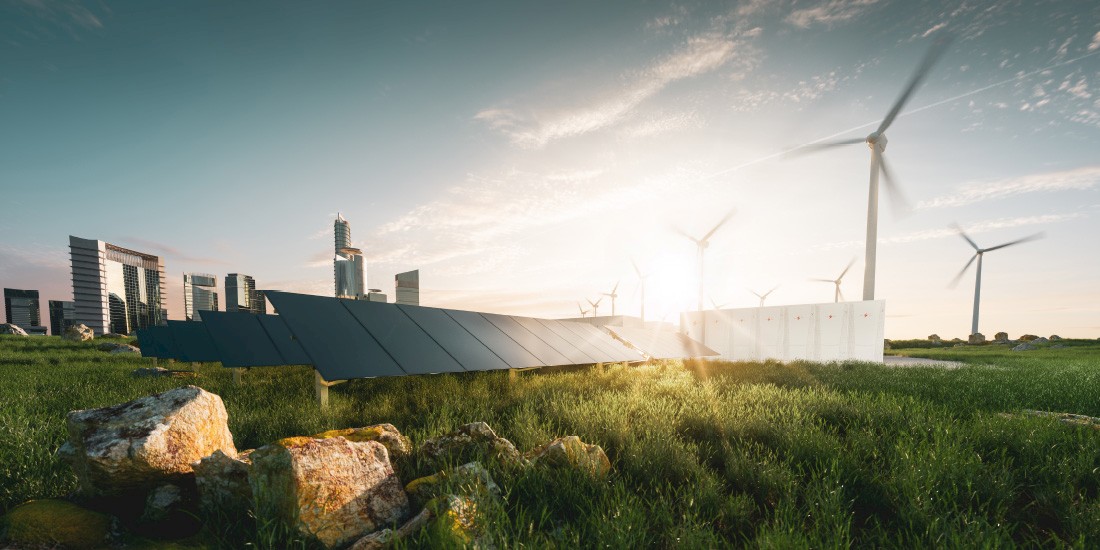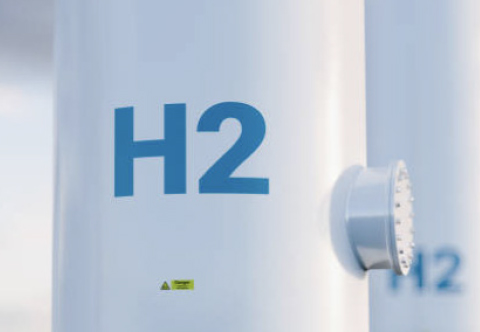Hydrogen applications
Hydrogen technologies – laying foundations today for tomorrow
If the energy turnaround is to succeed, so-called sector coupling, i.e. the interlinking of electricity, heat and mobility, is crucially important. H2ready products from Mannesmann Line Pipe could play an important part in this.
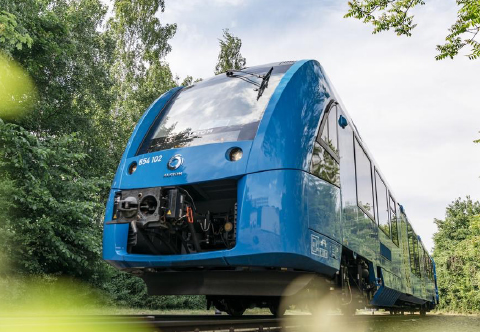
The Coradia iLint marks Alstom's launch of series production of hydrogen-powered trains.
Photo: © Alstom/Rene Frampe
“With our H2ready products we see ourselves as an important link in the coupling of sectors.”Andreas Betzler, Managing Director Mannesmann Line Pipe
"As in all other areas, we are very well networked in research and applications development in the hydrogen field," says Managing Director Andreas Betzler. Mannesmann Line Pipe is actively involved, for example, in the EnergyAgency.NRW network, cooperates with TÜV and the Fraunhofer Institute, and is strongly integrated in Salzgitter AG's group-wide activities.
Transition to series maturity
The excellently attended customer symposium in Siegen in December 2019 with its top-flight specialist lectures also ensured a lively exchange of ideas. The Mannesmann Line Pipe product portfolio for the transport and storage of hydrogen was also presented on this occasion. Numerous products developed to market maturity are available for the energy sector, industry, mobility and buildings. "We are not a silent market observer here, but see ourselves as an active partner who contributes constructively to our customers' energy turnaround," Betzler continues. "We are already transitioning from research and testing to series production implementation on an industrial scale." There are already plenty of examples of this.
Hydrogen finally comes into play
The rail network in Germany is around 34,000 kilometers long. 40 percent of this is not electrified and is operated with diesel engines. The rail vehicle manufacturer Alstom has been operating the world's first two hydrogen trains since 2017. The regional trains powered by fuel cells connect Bremervörde, Cuxhaven, Bremerhaven and Buxtehude. By the end of 2021, the line's entire diesel train fleet is to be replaced by 14 hydrogen trains. Track sections in Hesse and NRW will soon follow, and Alstom is on the verge of series production of the Coradia iLint.
Carbon-free public transport from waste
The public utility company Stadtwerke Wuppertal (WSW) and the waste management company Abfallwirtschaftsgesellschaft (AWG) are soon to put ten regular buses powered by fuel cells on the road. The vehicles will receive their hydrogen emission-free from the ultra-modern waste-to-energy plant in the south of Wuppertal. The daily hydrogen requirement is around 400 kilograms, which the waste-to-energy plant can reliably supply 365 days a year. In this way sustainable energy for public transport is generated from regional waste. After Wuppertal, for example, the waste-to-energy plant in Frankfurt – integrated in a project with the energy supplier Mainova – is also set to start producing hydrogen. The Allgäu also aims to become a hydrogen region. An analysis of potential shows that up to 1,000 metric tons of green hydrogen could be produced per year in a waste-to-energy plant and a hydropower plant.
Excellent network
With its H2ready program, Mannesmann Line Pipe offers a broad range of products for hydrogen applications. To promote developments within the framework of the energy turnaround, we have established an efficient network from research to trial right up to implementation. This includes renowned companies from the following areas:
- Chemical industry
- Gas network operators and suppliers
- Automotive industry
- Plant operators
- Research institutes
- Engineering offices
In addition, we have holdings in the networks of Hypos, the DVGW (German Gas and Water Association), the DWV (German Business Association), the EnergieAgentur.NRW (EnergyAgency NRW), the Salcos® project of Salzgitter AG and the IRO (Institute for pipeline construction at Oldenburg Technical College), and we cooperate inspection societies.
Hydrogen filling stations
However, so that buses, garbage collection vehicles and private cars can refuel with hydrogen, filling stations are needed. One such station has been in existence in Siegen since June 2019, the first of its kind in southern Westphalia and one of currently 16 in North Rhine-Westphalia. Over 100 filling stations are planned for Germany by the end of 2020. Given a total of 1,000, about one in 15 filling stations would supply hydrogen. Then one could speak of a nationwide supply – provided there is enough hydrogen available.
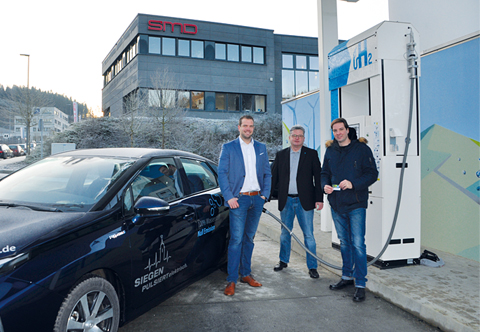
Manuel Simm, Konrad Thannbichler and Dominik Eichbaum, business development department of Siegen municipality, trying out the new hydrogen filling station in Siegen.
Photo: © Mannesmann Line Pipe GmbH
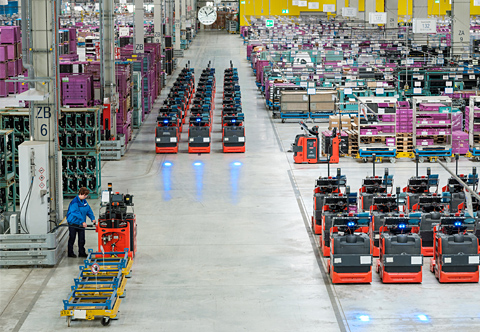
The BMW Group plant in Leipzig has been operating a large fleet of hydrogen-powered indoor factory trains since the end of 2018. These are used in production to supply the assembly lines with vendor parts.
Photo © BMW Group
The future of intralogistics
In-plant transport plays an increasingly important role in manufacturing companies and the trade sector. The intralogistics industry is therefore more advanced than many others when it comes to hydrogen/fuel cells. With its annual fruit and vegetable turnover of around 270,000 tons, the Paris Prelodis logistics center, for example, is Europe's first 100-percent hydrogen location. "We were motivated by potential cost savings, ease of use, lack of battery charge room and also the enthusiasm to open a new site with innovative technology", says Philippe Giroux, CEO Prelodis, Prelocentre Group. The Mercedes Benz plant in Düsseldorf, the BMW plant in Leipzig and DB Schenker in Linz are also setting new standards in hydrogen-based intralogistics. In the meantime, all well-known manufacturers of industrial trucks now have hydrogen-based pallet trucks, tractors and forklifts ready for series production.
Excess electricity in the grid
The production of hydrogen is energy-intensive. In the case of "gray" hydrogen, the production of a single metric ton generates around 10 tons of carbon. With carbon-neutral energy from the wind and sun, however, previously undreamt-of possibilities are now opening up for the production of "green", i.e. carbon-neutral, hydrogen. Peaks in solar and wind power are already producing surplus electricity today. Using these periods for "dynamic electrolysis" offers enormous opportunities. So the industrial-scale pilot plant of the electricity grid operator Amprion with the gas pipeline operator Open Grid Europe (OGE) has come at just the right time. A hydrogen electrolysis plant with an output of 100 megawatts is to be built in Lower Saxony. Electricity producers can then use this to convert surplus wind power into hydrogen that can be stored and transported.
Pioneer Salzgitter AG
Steel production is also energy-intensive. In terms of process engineering, there is basically nothing that can be changed. Salzgitter AG has therefore decided – as the world's very first steel producer – to decarbonize its steel production using green hydrogen. Hydrogen is to replace coke and coal in the extraction of iron, while the hydrogen itself is to be produced in a climate-neutral process using electricity from renewable energies. To this end, seven wind turbines are to be commissioned on the Salzgitter AG Group premises in 2020, generating around 400 standard cubic meters of hydrogen per hour (scm³/h). In the first stage of the project, carbon emissions have been reduced by as much as 26 percent. If steel production were converted in its entirety to the new process route with direct reduction plants, electrolyzers and electric arc furnaces, a reduction of up to 95 percent would be possible.
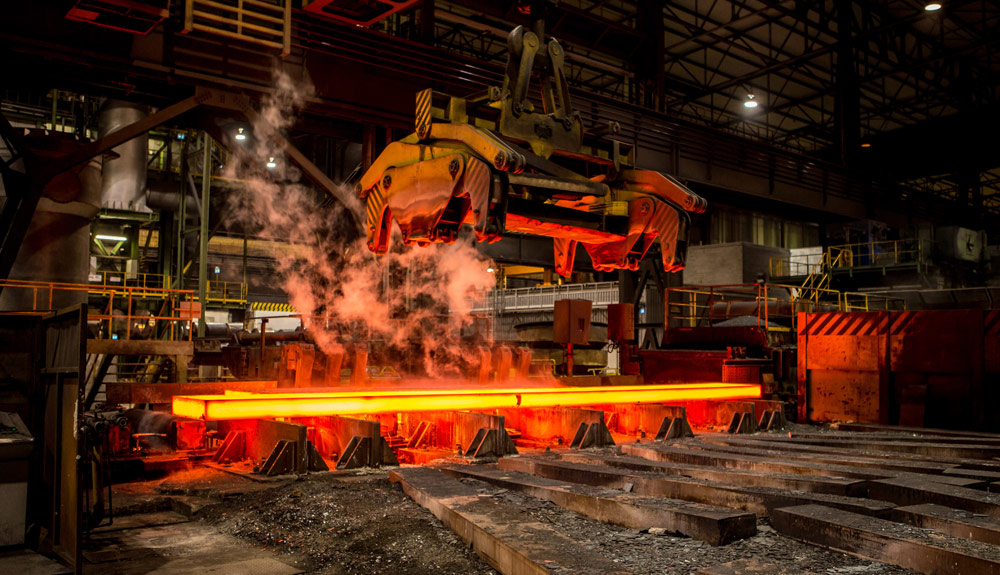
Salzgitter AG is the first steel producer in the world to have decided to decarbonize its production process by using green hydrogen.
Photo: © Salzgitter AG
National hydrogen strategy
The issue has also been addressed on the political level, as is demonstrated by the "National Hydrogen Strategy" planned by the Federal Government. This strategy is intended to dovetail climate, energy, industrial and innovation policy. "The future belongs solely to green hydrogen", said Federal Research Minister Anja Karliczek recently in an interview with the Handelsblatt. "In the National Hydrogen Strategy we should think green, global and big," she insisted. This was echoed by her fellow cabinet member Peter Altmaier at the Hydrogen and Energy Transition Conference in Berlin on 11/5/2019: "Gaseous energy carriers, and especially hydrogen, will be a key resource for a successful energy transition in the long term. At the same time, the generation of carbon-free and carbon-neutral hydrogen offers great opportunities for industrial policy. It is up to us to seize these opportunities and lay the foundations today for Germany to become the world's No. 1 in hydrogen technologies." It therefore comes as no surprise that there are now numerous research and funding programs from the ministries. In the field of hydrogen technology, the Federal Ministry of Education and Research (BMBF) is funding highly innovative approaches to production, transport and use to the tune of 180 million euros until 2021. In addition, over 300 million euros is available from the climate fund until 2023.
Research for the future
Mannesmann Line Pipe will also continue its research and development efforts. Current projects include
- Material behavior with a high hydrogen content in natural gas
- Material behavior with extreme load fluctuations
- Interaction of linings in a hydrogen atmosphere
"We do not want to rest on our laurels, because with our H2ready products we see ourselves as an important link in the coupling of sectors. The transport, distribution and storage of hydrogen will be all-important in a future hydrogen economy across all sectors," Andreas Betzler concludes.

Photo: © Laurence Chaperon
"The future belongs solely to green hydrogen. In the National Hydrogen Strategy we should think green, global and big."Anja Karliczek, Federal Research Minister
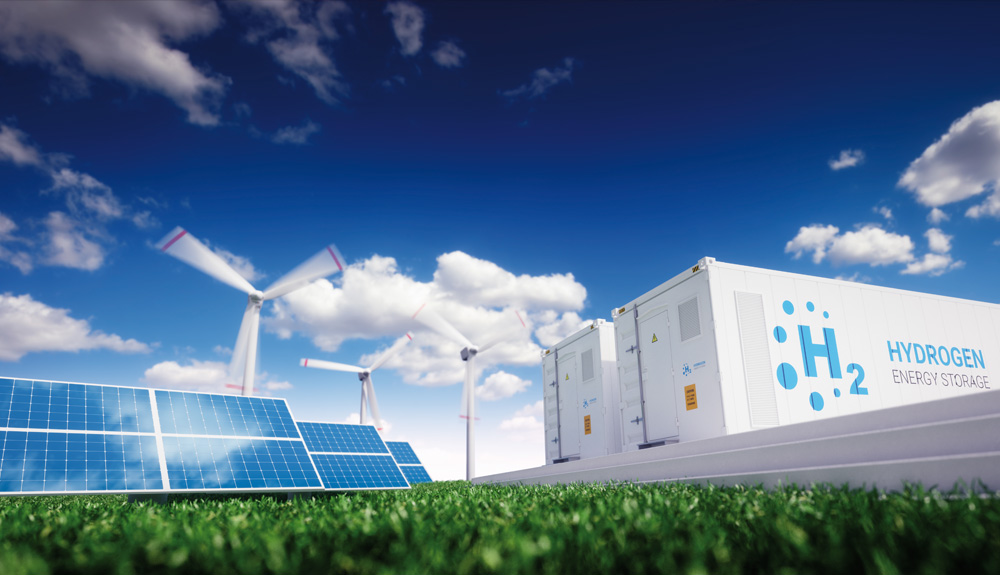
Further information on our Mannesmann pipes for hydrogen transport and storage can be found on our website
https://www.mannesmann-innovations.com
Hydrogen glossary
Hydrogen – green, gray, blue, turquoise
Green hydrogen is produced from water by electrolysis, using only carbon-free electricity from renewable energy sources. Production is therefore carbon-free. Gray hydrogen is derived from fossil fuels. As a rule, natural gas is converted into hydrogen and CO2 on exposure to heat (steam reforming). The CO2 is released unused into the atmosphere, thereby intensifying the global greenhouse effect: the production of one ton of hydrogen generates around 10 tons of CO2. Blue hydrogen is gray hydrogen, but its CO2 is captured at source and stored. The CO2 produced during hydrogen production does not enter the atmosphere. Turquoise hydrogen is produced by thermally splitting methane (methane pyrolysis). Instead of CO2, solid carbon is produced. Essential for carbon neutrality is the use of renewable energy sources and long-term carbon capture and sequestration.
Hydrogen economy
is an energy economy that uses mainly or exclusively hydrogen as its energy carrier. Although hydrogen is a primary energy carrier in chemical terms, its production requires the use of other energy sources. Thus, a hydrogen economy is only as sustainable as the primary energy from which the hydrogen is obtained.
Mannesmann H2ready
Specially developed and qualified for the transport of hydrogen, our steel pipes feature mechanical and technological properties that exceed the requirements of the EIGA directive and ensure optimum safety and service life. Further information is available at https://www.mannesmann-innovations.com.
Fuel cell
Fuel cells do not store energy, but convert it. A fuel cell is a galvanic cell that converts the chemical reaction energy of a continuously supplied fuel and an oxidant into electrical energy. Although the term fuel cell often refers to a hydrogen-oxygen fuel cell, methanol, butane or natural gas can also be used, depending on the type.
